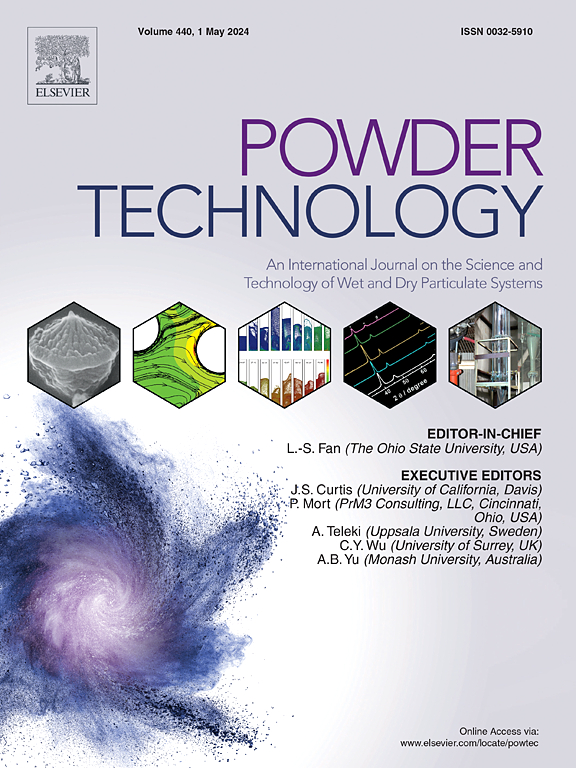使用基于copula的概率建模方法定量表征不同混合强度下的疏水团聚
IF 4.5
2区 工程技术
Q2 ENGINEERING, CHEMICAL
引用次数: 0
摘要
研究了小的湿性差的氧化铝颗粒在搅拌槽中的团聚现象。在不同的实验条件下,利用内联相机系统的二维图像数据,分别确定了初级颗粒和团聚体的面积等效直径和长宽比的两个二元概率密度。在整个实验过程中,由于原始粒子的几何形状不受实验条件的影响,这些密度不会改变,而大团块会分裂成多个小团块,这导致团块描述符的分布处于平衡状态。这些密度的混合物用于模拟搅拌槽在实验的每个时间步的内容物。分析函数,其参数表征团聚动力学,拟合到这些混合物的时间依赖的权重。这使得团聚过程的定量比较,突出混合强度对团聚描述符的联合分布的影响。本文章由计算机程序翻译,如有差异,请以英文原文为准。

Quantitative characterization of hydrophobic agglomeration at different mixing intensities using a copula-based probabilistic modeling approach
The agglomeration of small poorly wetted alumina particles in a stirred tank is investigated. For different experimental conditions, two bivariate probability densities for the area-equivalent diameter and aspect ratio of primary particles and agglomerates, respectively, are determined, using 2D image data from an inline camera system. Throughout each experiment, these densities do not change since the geometries of primary particles are unaffected by the experimental conditions, while large agglomerates fragment into multiple smaller ones, which results in an equilibrium state regarding the distribution of agglomerate descriptors. Mixtures of these densities are used to model the contents of the stirred tank at each time step of the experiments. Analytical functions, whose parameters characterize the agglomeration dynamics, are fitted to the time-dependent weights of these mixtures. This enables a quantitative comparison of agglomeration processes, highlighting the impact of mixing intensity on the joint distribution of agglomerate descriptors.
求助全文
通过发布文献求助,成功后即可免费获取论文全文。
去求助
来源期刊

Powder Technology
工程技术-工程:化工
CiteScore
9.90
自引率
15.40%
发文量
1047
审稿时长
46 days
期刊介绍:
Powder Technology is an International Journal on the Science and Technology of Wet and Dry Particulate Systems. Powder Technology publishes papers on all aspects of the formation of particles and their characterisation and on the study of systems containing particulate solids. No limitation is imposed on the size of the particles, which may range from nanometre scale, as in pigments or aerosols, to that of mined or quarried materials. The following list of topics is not intended to be comprehensive, but rather to indicate typical subjects which fall within the scope of the journal's interests:
Formation and synthesis of particles by precipitation and other methods.
Modification of particles by agglomeration, coating, comminution and attrition.
Characterisation of the size, shape, surface area, pore structure and strength of particles and agglomerates (including the origins and effects of inter particle forces).
Packing, failure, flow and permeability of assemblies of particles.
Particle-particle interactions and suspension rheology.
Handling and processing operations such as slurry flow, fluidization, pneumatic conveying.
Interactions between particles and their environment, including delivery of particulate products to the body.
Applications of particle technology in production of pharmaceuticals, chemicals, foods, pigments, structural, and functional materials and in environmental and energy related matters.
For materials-oriented contributions we are looking for articles revealing the effect of particle/powder characteristics (size, morphology and composition, in that order) on material performance or functionality and, ideally, comparison to any industrial standard.
 求助内容:
求助内容: 应助结果提醒方式:
应助结果提醒方式:


